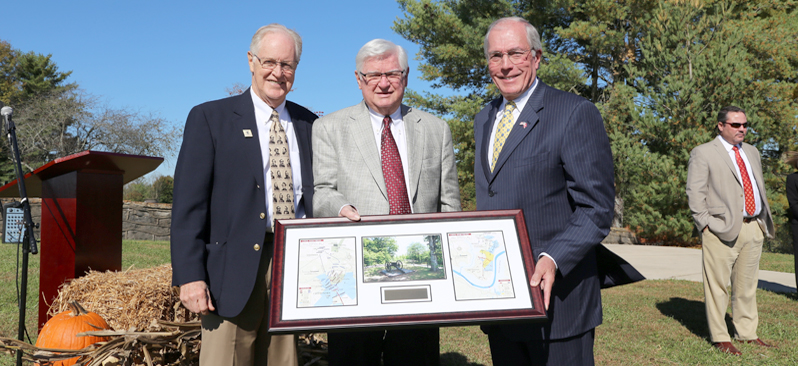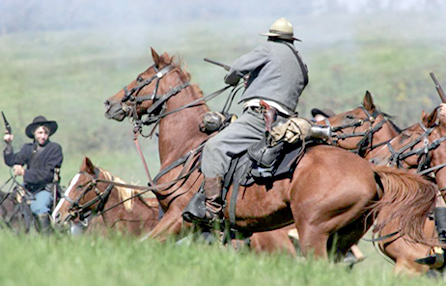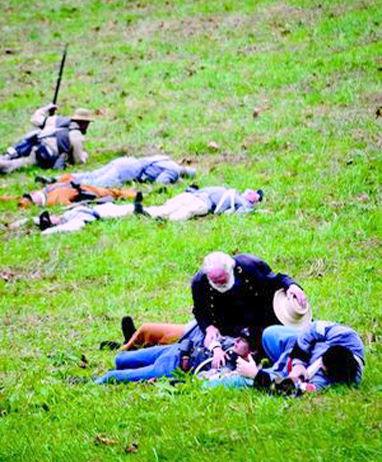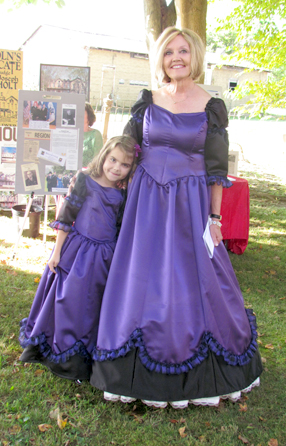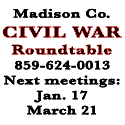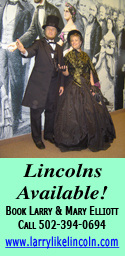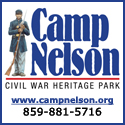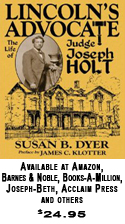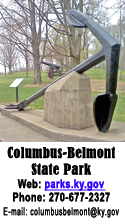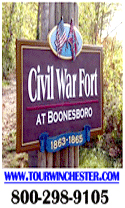Who would you support?
A recent poll indicates Americans continue to be divided as to
whether they would have supported the North or the South
during the Civil War. This photo, taken at July’s re-enactment
of the First Battle of Manassas (Bull Run), also tends to support
that finding. See story.
– Richmond (Va.) Times-Dispatch photo by Kevin Morley
|
|
‘Gun him down’
Perryville Battlefield has been named by author Jeff Shaara as one of the 10 great
Civil War places to visit. This photo was taken at last fall’s re-enactment
commemorating the Battle of Perryville’s 150th anniversary. See Briefs.
– Clay Jackson photo, Danville Advocate Messenger
|
|
|
|
Ninety-five and counting…
More acreage preserved at Mill Springs
by Civil War Trust, battlefield group
U.S. Rep. Hal Rogers and officials of the Civil War Trust and Mill Springs Battlefield Association (MSBA) have announced preservation of two historic properties associated with the 1862 battle and battlefield. The two properties, totaling 95 acres and known locally as the Landmark Ventures tract and Gladstone-Muse tracts, will be added to the 450 acres currently protected in the privately run battlefield park. Read more
Americans still divided about which side
they would have supported during War
One thing about the Civil War appears to be unchanged. Americans continue to be divided about which side they would have supported.
According to a recent survey by YouGov, an international opinion polling firm, slightly more than half of U.S. residents say would have been on the Union side during the Civil War. Read more
Holt House restoration nearing fruition
thanks to undying efforts of Susan Dyer
By ED FORD
Bugle Editor
Susan Dyer is dogged determination with a winning smile.
Or, as Judge-Executive Maurice Lucas relates, “I have never met anyone with the commitment or desire of Ms. Dyer to devote so much effort to any project.”
The project is the historic Joseph Holt home in Breckinridge County, an 1850s-era mansion built by the nation’s first Judge Advocate General who also was the presiding official in the trial of the Abraham Lincoln assassination conspirators.
Read more
Why couldn’t average Civil War soldier
hit anything? Practice was sadly lacking
The average Civil War soldier couldn’t hit the proverbial bull in the behind with a bass fiddle.
Training would have helped, but training in marksmanship was something woefully lacking in most commands during the Civil War. Little time or ammunition was allocated to actual range practice – and many recruits went into battle without having fired a single practice round. Read more
Octagon Hall served as safe haven
for Confederate soldiers
There’s only one eight-sided house in Kentucky. Not surprisingly, it’s called Octagon Hall.
In 1847, Andrew Jackson Caldwell laid out the foundation for his new family home in Simpson County with a desire for distinction. His home would not be a simple structure with four walls, but an eight-sided edifice unique to the region. Read more
Jeff Davis pushed U.S. Camel Corps,
initiated highly successful experiment
The U.S. Camel Corps was an experiment encouraged by Jefferson Davis, but then disbanded when the Kentuckian became president of the Confederacy.
Davis, U.S. Secretary of War in 1853, supported the idea of using camels to deliver mail and materiel to the desert area of the West. Two years later, he was able to get the “far-fetched” idea funded and the first ship sailed to the Middle East where the animals were purchased and brought to America. Thirty-three camels and drovers were brought to Indianola, Texas, on the initial trip and another 41 arrived on a second voyage. Read more
News in brief...
Fields takes U.S. Grant portrayal
into Civil War Trust video series
Sometimes things and events just happen at the right time.
That was the case for videographer Garry Adelman who was shooting footage at a recent Civil War Trust board of directors meeting in Greenwood, Miss.
Adelman was covering the event at Greenwood’s Museum of the Mississippi Delta that included an address by Curt Fields, who portrays Union Gen. U.S. Grant. Fields was speaking about the importance of Fort Pemberton in Grant’s Yazoo River expedition.
Read more
|
|
|
|
Some Civil War veterans became heroes
much later – after war was concluded
By BRYAN BUSH
Bugle Staff Writer
Confederate Major John Hess Leathers was a Civil War champion of a different sort. He was a hero with a heart of gold.
Born in 1841 in Northern Virginia, Leathers was the son of a cabinetmaker and the youngest of seven children. While working for his father, he learned the skills of writing bills of sale, delivering invoices and keeping inventory, which would serve him well later in his life. By age 16, Leathers was working at a dry goods store in Martinsburg, Va. Read more
Kentucky's Civil War leaders
Western Theater was great for Pope,
but he didn't fare as well in the East
Union Major Gen. John Pope had a brief, but successful career in the Civil War’s Western Theater.
But things didn’t fare so well for the Louisville native when the Lincoln Administration brought him to the troubled Eastern Theater to lead the newly formed Army of Virginia. Read more
Lindsey began colorful career raising
Union troops at Camp Dick Robinson
Col. Daniel Weisiger Lindsey became known initially when he helped raise the first group of Union troops in Kentucky.
The Frankfort native accomplished that task at Camp Dick Robinson in Garrard County as he worked with Gen. William (Bull) Nelson, who marched the first group of recruits into the camp on Aug. 6, 1861. That made it the first Federal base south of the Ohio River.
Read more
Tax, borrow, print; three ways used
by both sides to finance Civil War
There are only three ways to finance a great war, a prominent business-economic history journalist states.
A government can tax, it can borrow and it can print and the Union and Confederate governments did all three during the Civil War, John Steele Gordon points out. But the particular mix of each turned out to be fundamentally important to the outcome of the war, he continues. Read more
A tale of two Civil War brothers
By VIRGINIA VASSALLO
He woke up to find the wounded soldier staring at him with questioning eyes.
“You look like a boy in my company,” the soldier said. “What’s your name?”
“Felix Viskniskki.”
“Sounds like his last name too.” Read more
What’s wrong with Civil War books?
Four areas require some consideration
By DOUGLAS LIPPMAN
Bugle Staff Writer
Although electronic books are taking the place of printed books today, one theme remains constant. Of all the non-fiction subjects chosen by writers, the American Civil War is the leader. Each year, hundreds of new books on the subject are added to the list of those already in print. Older books are reprinted, or made available as electronic presentations. The American Civil War has long mesmerized the public and yet there remain certain basic problems in most Civil War publications. Read more
The Dahlgren Papers. . .
Teenager’s search led to war ‘violation’
that may have prompted Lincoln murder
Thirteen-year-old William Littlepage was walking past Union bodies following a failed raid (March 2, 1864) near Richmond, Va., when he stopped to view the corpse of Col. Ulric Dahlgren.
He searched through the pockets of the dead Yankee officer, hoping to find a pocket watch. Instead, he discovered a small notebook and two folded papers. He glanced through the documents, then promptly gave them to his teacher, Edward W. Halbach, who was a captain in the Confederate Virginia Home Guard. Read more
|
|
|

